Salzburg was famously the birthplace of Wolfgang Amadeus Mozart, and his home base until his move to Vienna in 1781. But it was also where Michael Haydn – the younger brother of better-known Joseph Haydn – worked for 43 years, from 1763 to 1806, after moving here from Vienna; Michael Haydn was as highly regarded in his lifetime as both his older brother and Mozart. The city and surrounding countryside were the setting for the film The Sound of Music (actually a little way down my own musical list!). It's a fabulously attractive city, with several outstanding churches and other buildings, all overlooked by the remarkable Hohensalzburg fortress... / more |
The Mozarts
In 1747 the violinist Leopold Mozart married Anna Maria Pertl, and they set up home in a small flat in a house in Getreidegasse, in the centre of Salzburg. Here their seven children were born, although only two survived childhood: Maria Anna Walburga, born 1751 and known in the family as 'Nannerl'; and Johannes Chrysostomus Wolfgangus, born in 1756 and known universally as 'Wolfgang Amadeus Mozart'. Today the house is the Mozarts Geburtshaus museum. After 26 years in Getreidegasse the family moved across the river to the 'Dancing Master's House', itself now also an excellent museum...
• Click for photos and more |
 |
Domkirche
With the sun strong and the sky blue, I walked round to Domplatz to get some photos of the stunning white west façade of the Dom, Salzburg's cathedral, and of the statue in the centre of the square, with the light in just the right place. I had to dodge quite a few tourists, and probably got in the way of some myself, but at least I wasn't sitting on the statue and spoiling it for other photographers! Inside the cathedral I was bowled over by the ceiling frescoes, and tried to do my best to get photos. Also some photos of the font, to the left of the main door, in which Mozart was christened...
• Click for photos and more |
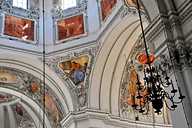 |
Peterskirche
The Peterskirche [St Peter's church] has a wonderful 18th Century white and gold Rococo interior. The building itself dates back to the 12th Century, with several later additions including the Romanesque portal of about 1240, and the St Veits Chapel from 1319. My particular interest in the church was to seek out the memorial to Michael Haydn, which I found eventually in a dark place about halfway down the right hand aisle. Michael Haydn was a very highly regarded musician in his day...
• Click for photos and more |
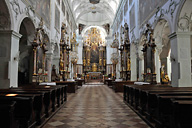 |
Festspielhaus
A back-stage tour of the Festspielhaus, the large + small opera house complex now used mainly for the Salzburg Festival, was an opportunity too good to miss. The present design of the large hall, the Großes Festspielhaus, was the brainchild of Herbert von Karajan, director of the Festival for many years, who opened it in 1960 with a performance of Richard Strauss's Der Rosenkavalier. It has the biggest opera stage in the world, though by no means the largest auditorium...
• Click for photos and more |
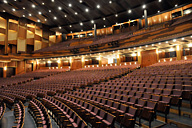 |
View from above
On the way back from the station after my day trip to St Florian, I climbed the very steep path to the Mönchsberg, the wooded ridge that towers 60 metres over the south-west edge of the city. The views over Salzburg were breathtaking, and the evening sun was picking out the domes and spires of the churches. I spent some time reviewing the places I'd been and the routes I'd followed through the city. The following morning, with sunshine forecast, I was up early and by 08:00 had puffed my way up the hill again to catch the morning sun and clear blue sky...
• Click for photos and more |
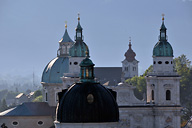 |
Hohensalzburg
From the Mönchsberg I walked along the ridge to the Hohensalzburg, the massive fortress that guards the city, arriving there a few minutes before its 09:00 opening time. The sun was strong and direct, and the walls inside almost white, so the contrast was incredible. I concentrated on getting my photos before the crowds arrived, but in the event there was no big rush. There seemed to be pictures everywhere. The presentation of the Hohensalzburg is nicely done, with discreet signage and an excellent inside tour...
• Click for photos and more |
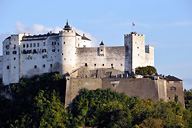 |
Mirabell Gardens
It was grey and raining for my visit to the Mirabellgarten, but the flower displays were superb and the flat lighting was on my side for a change, enabling some good colour saturation and a chance to hang on to some shadow detail in the pictures. The gardens were laid out in 1690 by the influential Baroque architect Fischer von Erlach – whose long CV also includes Schönbrunn Palace and the Karlskirche in Vienna – and they were redesigned again around 1730 by Franz Anton Danreiter. The 1661 statue of the winged horse Pegasus, by Kaspar Gras, was moved here in 1913, and provided me with some foreground interest for my distant view of the Hohensalzburg...
• Click for photos and more |
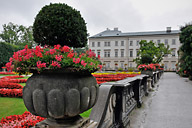 |
I arrived in Salzburg at midday on a Saturday and bought a one-week bus card for €12, which paid for itself on the first day as I needed to make several journeys to and from the hotel, just outside the centre, and back to the Hauptbahnhof to reserve seats on my trains to Klagenfurt and Vienna. As I sat outside eating my snack lunch, enjoying the unfamiliar pleasure of some warm sunshine, I noticed a sign promoting the back-stage tour of the Festspielhaus – an opportunity too good to miss. |
|
|